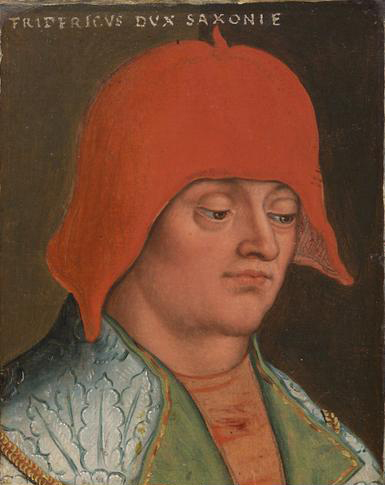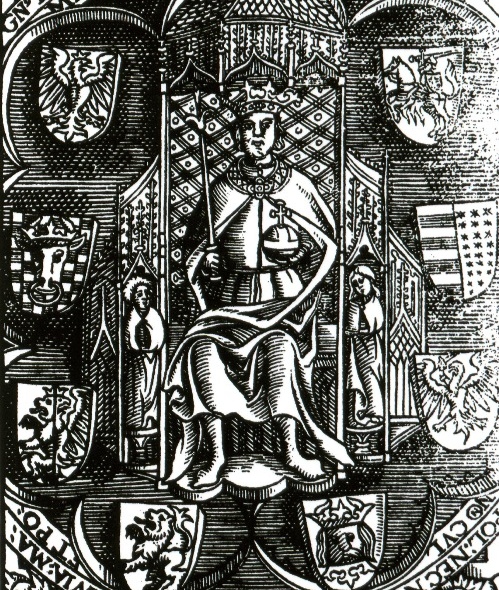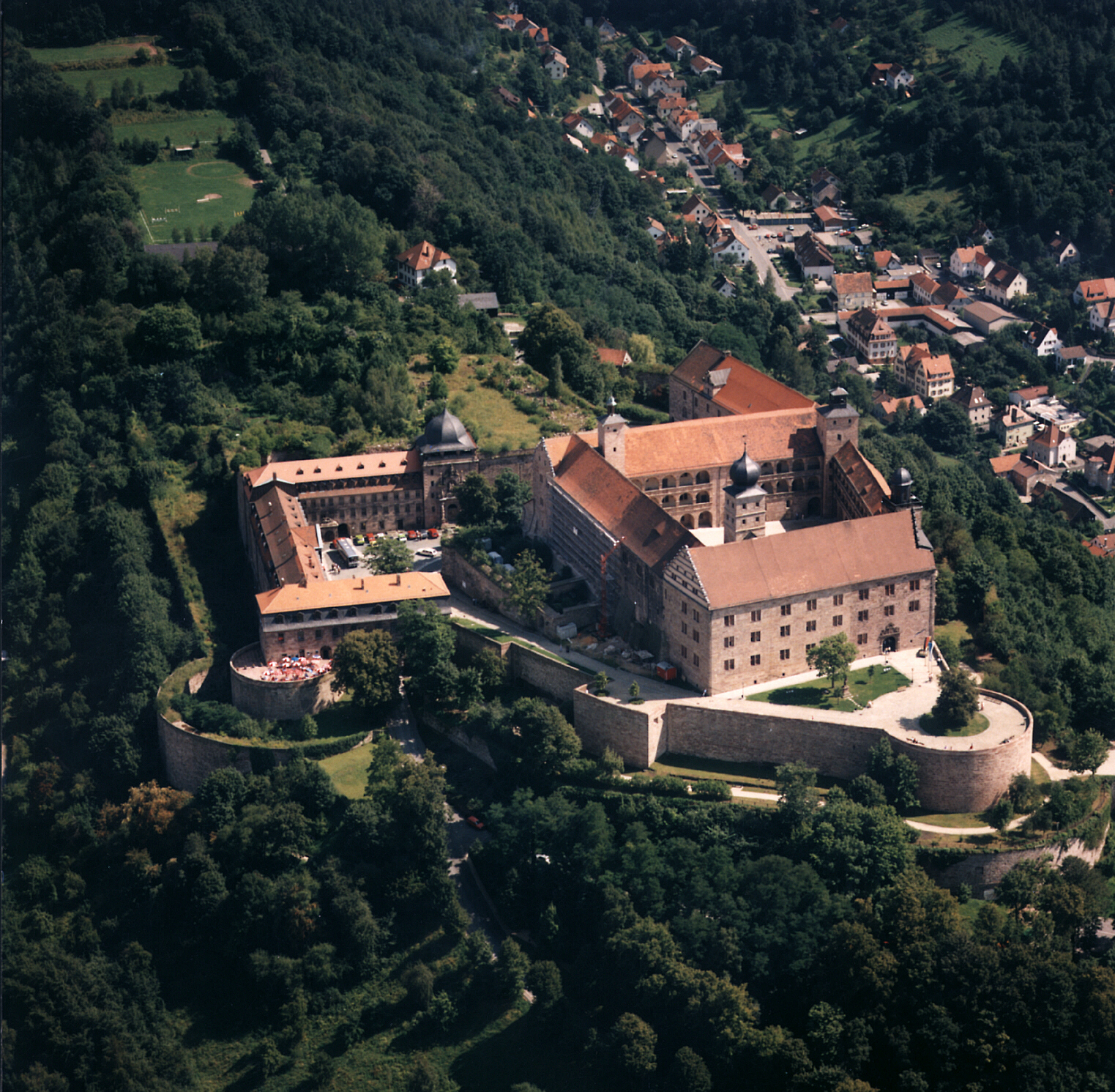|
Frederick I, Margrave Of Brandenburg-Ansbach
Frederick I of Ansbach and Bayreuth (also known as Frederick V; or ; 8 May 1460 – 4 April 1536) was born at Ansbach as the eldest son of Albert III, Margrave of Brandenburg by his second wife Anna of Saxony (d. 1512), Anna, daughter of Frederick II, Elector of Saxony. His elder half-brother was the Elector John Cicero of Brandenburg. Friedrich succeeded his father as Margrave of Ansbach in 1486 and his younger brother Siegmund, Margrave of Bayreuth, Siegmund as Margrave of Bayreuth in 1495. After depleting the finances of the margraviate with his lavish lifestyle, Frederick I was deposed by his two elder sons, Kasimir, Margrave of Bayreuth, Casimir and George, Margrave of Brandenburg-Ansbach, George, in 1515. He was then locked up at Plassenburg, Plassenburg Castle by his eldest son Casimir in a tower room from which he could not escape for 12 years. Thereupon, his son Casimir took up the rule of the Margraviate of Bayreuth (Kulmbach) and his son George took up the rule of the ... [...More Info...] [...Related Items...] OR: [Wikipedia] [Google] [Baidu] |
Margrave Of Ansbach
The Principality or Margraviate of (Brandenburg) Ansbach ( or ) was a principality in the Holy Roman Empire centered on the Franconian city of Ansbach. The ruling House of Hohenzollern, Hohenzollern princes of the land were known as margraves, as their ancestors were margraves (so the principality was a margraviate but not a marches, march). History The principality was established following the death of Frederick V, Burgrave of Nuremberg, on 21 January 1398. By agreement, his lands were partitioned between his two sons, a process that took more than two years. The younger son, Frederick I, Elector of Brandenburg, Frederick VI, received Ansbach and the elder, John III, Burgrave of Nuremberg, John III, received Principality of Bayreuth, Bayreuth. After John III's death on 11 June 1420, the two principalities were reunited under Frederick VI, who had become Prince-elector, Elector Frederick I of Brandenburg in 1415. On 21 September 1440, almost three years after Frederick's deat ... [...More Info...] [...Related Items...] OR: [Wikipedia] [Google] [Baidu] |
Frederick II, Elector Of Saxony
Frederick II, The Gentle (''Friedrich, der Sanftmütige''; Frederick the Gentle; 22 August 1412 – 7 September 1464) was Elector of Saxony (1428–1464) and was Landgrave of Thuringia (1440–1445). Biography Frederick was born in Leipzig, the eldest of the seven children of Frederick I, Elector of Saxony, and Catherine of Brunswick-Lüneburg, Catherine of Brunswick and Lunenburg. After the death of his father in 1428 he took over the government together with his younger brothers William III, Duke of Saxony, William III, Henry and Sigismund. In 1433 the Wettin (dynasty), Wettins finally concluded peace with the Hussites and in 1438 Frederick led Saxon forces to victory in the Battle of Sellnitz. That same year it was considered the first federal state parliament of Saxony. The parliament received the right to find together in case of innovations in fiscal matters also without summoning by the ruler. Also in 1438 it was decided that Frederick, and not his rival Bernard IV, duk ... [...More Info...] [...Related Items...] OR: [Wikipedia] [Google] [Baidu] |
Liegnitz
Legnica (; , ; ; ) is a city in southwestern Poland, in the central part of Lower Silesia, on the Kaczawa River and the Czarna Woda. As well as being the seat of the county, since 1992 the city has been the seat of the Diocese of Legnica. Legnica had a population of 97,300 inhabitants. The city was first referenced in chronicles dating from the year 1004, although previous settlements could be traced back to the 7th century. The name "Legnica" was mentioned in 1149 under High Duke of Poland Bolesław IV the Curly. Legnica was most likely the seat of Bolesław and it became the residence of the dukes of Legnica from 1248 until 1675. Legnica is a city over which the Piast dynasty reigned the longest, for about 700 years, from the time of ruler Mieszko I of Poland after the creation of the Polish state in the 10th century, until 1675 and the death of the last Piast duke George William. Legnica is one of the historical burial sites of Polish monarchs and consorts. Legni ... [...More Info...] [...Related Items...] OR: [Wikipedia] [Google] [Baidu] |
Buda
Buda (, ) is the part of Budapest, the capital city of Hungary, that lies on the western bank of the Danube. Historically, “Buda” referred only to the royal walled city on Castle Hill (), which was constructed by Béla IV between 1247 and 1249 and subsequently served as the capital of the Kingdom of Hungary from 1361 to 1873. In 1873, Buda was administratively unified with Pest, Hungary, Pest and Óbuda to form modern Budapest. Royal Buda is called the ''Castle Quarter (Budapest), Várnegyed'' () today, while “Buda” ''pars pro toto'' denotes Budapest’s I., II., III., XI., XII. and XXII. districts. This colloquial definition thus includes medieval Óbuda and amounts to a third of the city’s total area, much of it forested. Buda's landmarks include the Royal Palace (Budapest), Royal Palace, Matthias Church, the Citadella, Gellért Baths, the Buda Hills, the Carmelite Monastery of Buda, and the residence of the President of Hungary, Sándor Palace. Etymology Accord ... [...More Info...] [...Related Items...] OR: [Wikipedia] [Google] [Baidu] |
Sigismund I The Old
Sigismund I the Old (, ; 1 January 1467 – 1 April 1548) was List of Polish monarchs, King of Poland and Grand Duke of Lithuania from 1506 until his death in 1548. Sigismund I was a member of the Jagiellonian dynasty, the son of Casimir IV of Poland, Casimir IV and younger brother of Kings John I Albert and Alexander I Jagiellon. He was nicknamed "the Old" in later historiography to distinguish him from his son and successor, Sigismund II Augustus. Before ascending to the Polish and Lithuanian thrones, he was Duke of Głogów from 1499, Duke of Opava from 1501, and governor of Silesia from 1504 on behalf of his brother, King Vladislaus II of Hungary, Vladislaus II of Bohemia and Hungary. Sigismund was born in the town of Kozienice in 1467 as the fifth son of Casimir IV and his wife Elizabeth of Austria (1436–1505), Elizabeth of Austria. He was one of thirteen children and was not expected to assume the throne after his father. Sigismund's eldest brother and rightful heir Vladi ... [...More Info...] [...Related Items...] OR: [Wikipedia] [Google] [Baidu] |
Elizabeth Of Austria (1436–1505)
Elizabeth of Austria (; ; ; c. 1436 – 30 August 1505) was Queen of Poland and Grand Duchess of Lithuania as the wife of King Casimir IV of Poland. Orphaned at an early age, she spent her childhood in the court of Holy Roman Emperor Frederick III. As one of the three surviving grandchildren of Emperor Sigismund, she had a strong claim to the kingdoms of Hungary and Bohemia. That made her an attractive bride for a Polish prince. The Polish nobility, seeking to increase Polish influence in Hungary and Bohemia, pursued marriage with Elizabeth since she was born and finally succeeded in 1454. Her marriage to Casimir was one of the most successful royal marriages in Poland. She gave birth to thirteen children, eleven of whom survived to adulthood. Four of her sons were crowned as kings. Early life Tumultuous childhood Elisabeth was the daughter of Albert II of Germany, Archduke of Austria, and his wife Elizabeth of Luxembourg, daughter of Emperor Sigismund. The exact date of he ... [...More Info...] [...Related Items...] OR: [Wikipedia] [Google] [Baidu] |
Casimir IV Of Poland
Casimir IV (Casimir Andrew Jagiellon; ; Lithuanian: ; 30 November 1427 – 7 June 1492) was Grand Duke of Lithuania from 1440 and King of Poland from 1447 until his death in 1492. He was one of the most active Polish-Lithuanian rulers; under him, Poland defeated the Teutonic Knights in the Thirteen Years' War and recovered Pomerania. The Jagiellonian dynasty became one of the leading royal houses in Europe. The great triumph of his reign was bringing Prussia under Polish rule. The rule of Casimir corresponded to the age of "new monarchies" in western Europe. By the 15th century, Poland had narrowed the distance separating it from Western Europe and became a significant power in international relations. The demand for raw materials and semi-finished goods stimulated trade, producing a positive balance, and contributed to the growth of crafts and mining in the entire country. He was a recipient of the English Order of the Garter (KG), the highest order of chivalry and the mos ... [...More Info...] [...Related Items...] OR: [Wikipedia] [Google] [Baidu] |
Frankfurt (Oder)
Frankfurt (Oder), also known as Frankfurt an der Oder (, ; Central Marchian: ''Frankfort an de Oder,'' ) is the fourth-largest city in the German state of Brandenburg after Potsdam, Cottbus and Brandenburg an der Havel. With around 58,000 inhabitants, it is the largest German city on the Oder River, and one of the easternmost cities in Germany. Frankfurt sits on the western bank of the Oder, opposite the Polish town of Słubice, which was a part of Frankfurt until 1945, and called ''Dammvorstadt'' until then. The city is about east of Berlin, in the south of the historical region Lubusz Land. Within Frankfurt's city limits lies the recreational area Lake Helenesee. The name of the city makes reference to the Franks, and means '' Ford of the Franks'', and there appears a Gallic rooster in the coats of arms of Frankfurt and Słubice. The official name ''Frankfurt (Oder)'' and the older ''Frankfurt an der Oder'' are used to distinguish it from the larger city of Frankfurt a ... [...More Info...] [...Related Items...] OR: [Wikipedia] [Google] [Baidu] |
Augsburg
Augsburg ( , ; ; ) is a city in the Bavaria, Bavarian part of Swabia, Germany, around west of the Bavarian capital Munich. It is a College town, university town and the regional seat of the Swabia (administrative region), Swabia with a well preserved Altstadt (historical city centre). Augsburg is an Urban districts of Germany, urban district and home to the institutions of the Augsburg (district), Landkreis Augsburg. It is the List of cities in Bavaria by population, third-largest city in Bavaria (after Munich and Nuremberg), with a population of 304,000 and 885,000 in its metropolitan area. After Neuss, Trier, Worms, Germany, Worms, Cologne and Xanten, Augsburg is one of Germany's oldest cities, founded in 15 BC by the Romans as Augsburg#Early history, Augusta Vindelicorum and named after the Roman emperor Augustus. It was a Free Imperial City from 1276 to 1803 and the home of the patrician (post-Roman Europe), patrician Fugger and Welser families that dominated European ban ... [...More Info...] [...Related Items...] OR: [Wikipedia] [Google] [Baidu] |
Kulmbach
Kulmbach () is the capital of the district of Kulmbach in Bavaria in Germany. The town, once a stronghold of the Principality of Bayreuth, is renowned for its University of Life Sciences, a branch of the University of Bayreuth, the massive Plassenburg Castle, which houses the largest tin soldier museum in the world, for its brewery, its vivid food industry, which hosts some of the world's biggest food businesses, and for its sausages, or '' Bratwürste''. Geography Location Kulmbach is located in the middle of the Bavarian province of Upper Franconia, about northwest of the city of Bayreuth. To the south of Kulmbach, the River Main begins at the confluence of its headstreams, the White Main and Red Main. Town districts Kulmbach is divided into the following districts (with population in brackets): History From about 900 AD there was a small settlement in what is now the district of Spiegel, which consisted of a forest lodge and a fortified tenant farm (''Fronhof'') to ... [...More Info...] [...Related Items...] OR: [Wikipedia] [Google] [Baidu] |
Joachim I, Elector Of Brandenburg
Joachim I Nestor (21 February 1484 – 11 July 1535) was a Prince-elector of the Margraviate of Brandenburg (1499–1535), the fifth member of the House of Hohenzollern. His nickname was taken from King Nestor of Greek mythology. Biography The eldest son of John Cicero, Elector of Brandenburg, Joachim received an excellent education under the supervision of Dietrich von Bülow, Bishop of Lebus and Chancellor of Frankfurt University. He became Elector of Brandenburg upon his father's death in January 1499, and soon afterwards married Elizabeth of Denmark, daughter of King John of Denmark in 1502. They had five children: # Joachim II Hector (9 January 1505 – 3 January 1571) # Anna (1507 – 19 June 1567) married Albert VII, Duke of Mecklenburg-Güstrow # Elisabeth (24 August 1510 – 25 May 1558) in 1525 married firstly Eric I of Brunswick-Kalenberg and in 1545 secondly Poppo XII, count of Henneberg # Margaret (29 September 1511 – 1577), married firstly on 23 Janu ... [...More Info...] [...Related Items...] OR: [Wikipedia] [Google] [Baidu] |
Plassenburg
Plassenburg is a castle in the city of Kulmbach in Bavaria. It is one of the most impressive castles in Germany and a symbol of the city. It was first mentioned in 1135. The Plassenberg family were Ministerialis, ministerial of the counts of Andechs (later the dukes of Duchy of Merania, Andechs-Meranien) and used as their seat the Plassenburg. The House of Guttenberg, a prominent Franconian noble family, traces its origins back to 1149 with a Gundeloh v. Blassenberg (Plassenberg). The name Guttenberg is derived from Guttenberg, Bavaria, Guttenberg and was adopted by a Heinrich von Blassenberg around 1310. From 1340, the Hohenzollerns governed from Plassenburg castle their territories in Franconia till 1604. The Plassenburg was fortress and residence for the Hohenzollerns. It was destroyed in 1554 at the end of the second Margravian war (1552–1554) of margrave Albert Alcibiades. The Plassenburg was later rebuilt by the architect Caspar Vischer as an impressive stronghold and a ... [...More Info...] [...Related Items...] OR: [Wikipedia] [Google] [Baidu] |






